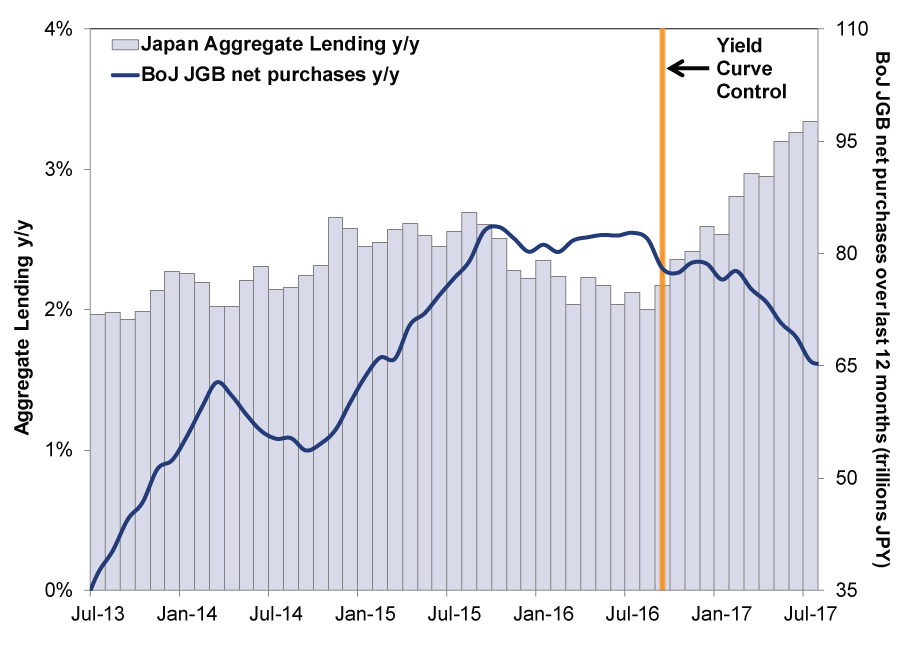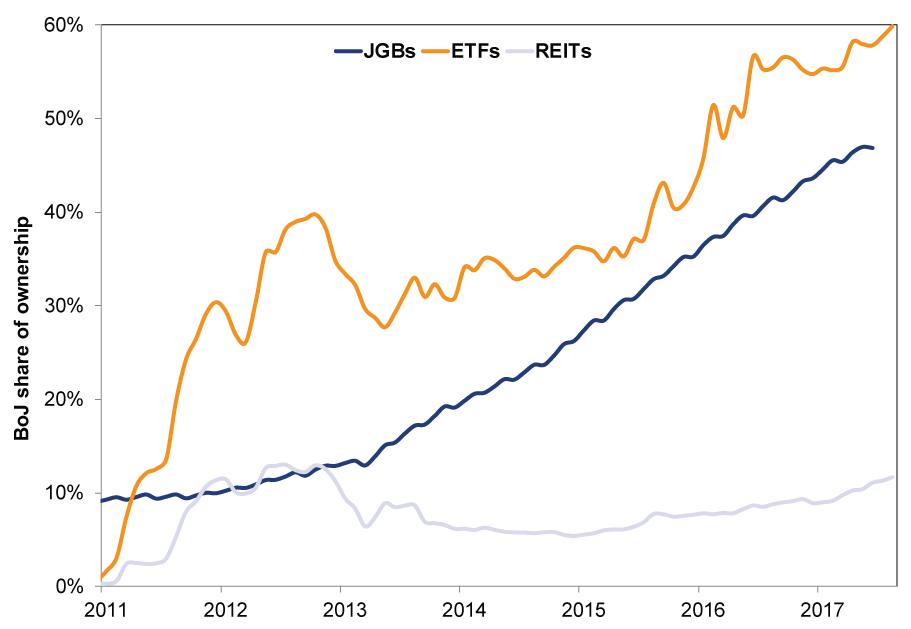Personal Wealth Management / Economics
The Curious Case of Japan’s Stealth QE Taper
The BoJ's latest policy shift is so surprising they may not even realize they are doing it.
In the last year, the BoJ has been most notable for its quiet. Publicly, the bank hasn't shifted policy at all from its large-scale asset purchases. No surprise expansions or new assets targeted. No forceful forward guidance. No new letters. Nevertheless the BoJ's asset purchases slowed noticeably over the past 12 months-a "stealth taper," if you will. Meanwhile, loan growth ticked higher, just as it did in America and Britain when the Fed and BoE tapered quantitative easing (QE). Whether intentionally or unintentionally, it seems to us the BoJ may have stumbled onto more sensible monetary policy.
The BoJ and Governor Haruhiko Kuroda have arguably been the leading proponents of long-term asset purchases-quantitative easing. They added a second "Q" (quantitative and qualitative easing) back in 2013, aimed at rapidly building up the monetary base with an aim to reach a 2% annual inflation growth rate. They also cut short-term interest rates into negative territory in 2016, in another misguided attempt to stoke inflation. At its peak, the BoJ bought ¥80 trillion in Japanese government bonds (JGBs), ¥6 trillion in ETFs and ¥90 billion in REITs, annually. These efforts have largely fallen short of their goal.
In September 2016, the BoJ changed course yet again and added three more letters to its monetary alphabet soup: YCC, or yield-curve control. The BoJ expressly targeted a 10-year JGB yield of 0%-at the time, up from -0.1%. This was intended to ease the pain on bank profitability brought by negative rates and the flat yield curve BoJ asset purchases wrought. Accomplishing this allowed JGB purchases to fluctuate. Over the past 12 months ending in August 2017, the BoJ purchased just ¥65 trillion in JGBs-a marked slowdown from the past couple years. For comparison's sake, over the same timeframe ending in August 2016, the BoJ bought ¥81 trillion in JGBs.
Interestingly, as the BoJ pursued YCC, Japanese lending accelerated, although it's unclear if the relationship is causal since the yield spread and net interest margins haven't expanded over the last year. (Exhibit 1) That said, the less active BoJ has likely helped by providing some predictability for markets in contrast to Kuroda's "bazooka" approach in 2014 or the surprise introduction of negative rates in 2016.
Exhibit 1: Japanese Lending Accelerating as BoJ JGB Purchases Decline
Source: BoJ, as of 9/15/2017.
Consensus expectations are for no changes in policy through the end of Kuroda's term in April 2018, and futures markets are not pricing any significant chance of a rate hike through the end of 2018. The BoJ could further taper QE through the YCC program by raising the target yield of the 10-year JGB, or they could allow 10-year rates to rise by targeting 5-year yields. While it is unclear what path the BoJ ultimately chooses, it is worth noting there are increasing capacity constraints-the BoJ now owns 47% of JGBs, 60% of ETFs and 12% of domestic REITs. (Exhibit 2) Banks, insurance companies and pensions might become unwilling sellers of JGBs at some point, as the IMF estimates these institutions need to hold about 5% of their collateral in JGBs-currently that figure is at 8.5%.
Exhibit 2: The BoJ Owns Nearly Half of All JGBs
Source: BoJ, Ministry of Finance, Japanese Investment Trusts Allocation, as of 9/15/2017.
In addition to capacity constraints, QE is deeply unpopular-a recent Reuters survey showed just 14% of Japanese businesses favored expanding it. There are also political pressures, as around half the funding of the governing Liberal Democratic Party (LDP) comes from Japanese banks-a group that would prefer to see a steeper yield curve and an end to QE and negative interest rates.
While we aren't forecasting future BoJ monetary policy-a futile effort, in our view-we believe the continued tapering or even outright ending of QE would remove an economic headwind facing the Japanese economy. It could also provide a sentiment boost, given the program's waning popularity. When places like the US and UK ended their QE programs, their economies and markets didn't collapse; on the contrary, growth picked up some. We don't see Japan returning to an economic powerhouse simply because the BoJ ends QE, but if investors' views fall further, some Japanese improvement could beat low expectations.
If you would like to contact the editors responsible for this article, please message MarketMinder directly.
*The content contained in this article represents only the opinions and viewpoints of the Fisher Investments editorial staff.
Get a weekly roundup of our market insights
Sign up for our weekly e-mail newsletter.

You Imagine Your Future. We Help You Get There.
Are you ready to start your journey to a better financial future?

Where Might the Market Go Next?
Confidently tackle the market’s ups and downs with independent research and analysis that tells you where we think stocks are headed—and why.








